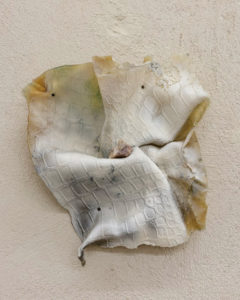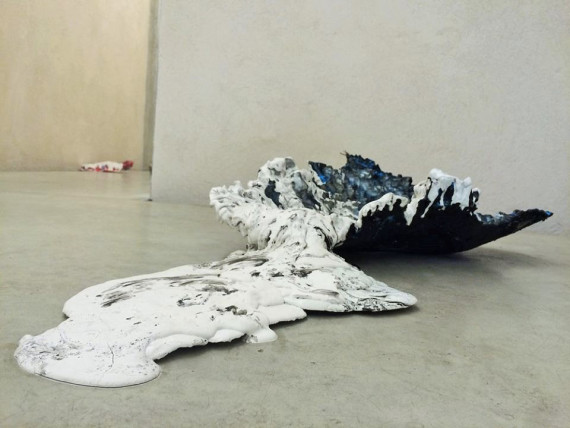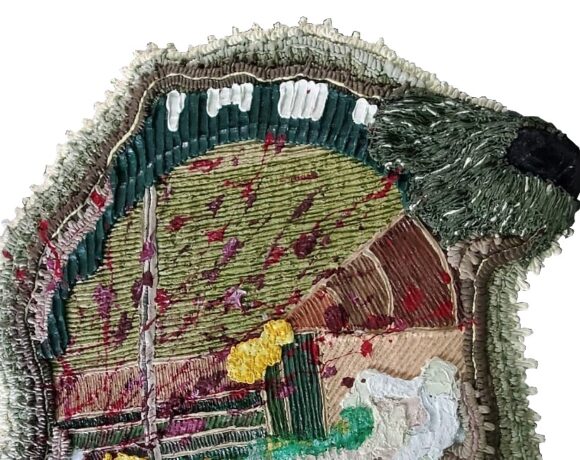The poetics of many contemporary artists finds its main source of inspiration in the striking similarities between the metamorphosis of artificial material and the natural transformations of the organic world while the constant oscillation between the biological and the synthetic universe, perhaps the most relevant technological and intellectual product of our time, has become an established creative process model in the field of visual arts. Since the ’90s, when Matthew Barney in the Cremaster cycle celebrated the unconscious of American culture in a triumph of jelly and vaseline with a spectacular epic of desire and sexuality, polyurethane foams, latex, resins and any other postmodern emulsion established themselves as essential artistic tools inducing new aesthetic canons and new ways of realization. These malleable and expandable materials when solidify create resistant forms that seem to crystallize a temporary condition of being explaining at the same time its indeterminacy and the delicate structures that they compose deceive the eye and touch with mysterious biological allusions. The new media, vehicles of an artistic practice that is allied with the chemical and industrial production, acquire more and more autonomy in the genesis of the artwork and become haunting metaphor of the unpredictability of the most sophisticated genetic and technological experiments that man triggers without being able to fully monitor the outcomes and long-term consequences.
These suggestions also ties into the work of the young Venetian artist Sebastiano Sofia manifesting the expressive and allusive potential of sculptural material intended as a scene for a continuous transformation in which a wide range of possibilities for hybridization and complementarity between artifice and nature takes place. His works combine natural elements in a raw state (branches or mineral stones) or modified by human intervention and wear (wooden building beams or glass fragments rounded by staying at sea), synthetic materials (concrete, resin and gypsum) and discarded objects (inner tubes, steel rods or plastic fragments). Each composition is presented as if it were the provisional result of an ongoing process of osmosis in which the artist plays the dual role of intermediary between separated worlds and witness of the result of their collision / fusion. The sculptural elements derived from these improper meetings seem in fact gradually losing their identity of objects to become strange creatures that move and breathe in a space-time that is different from ours but equally vital. Their exhibited slowness casts doubt on the supposed immobility of an inanimate object to evoke an embryonic state of being in which real and fictional organic suggestions mingle in the same emotional withdrawal. The qualification parameters of the things become labile and the most common opposing pairs merge into one another: if plaster and stucco lining the top of a wooden beam with lush blooms we are no longer sure about the objectivity of established concepts such as stiffness, tenderness, fragility, strength, fullness or cavities. If latex mimics the scaly texture of a creature dubious between a reptile and a siren and its bright colors suggest the industrial coating as well as the iridescence of some mythological fish, the fleshy folds that unfolds its solitary existence could be the protuberances of a tropical plant or the ultimate existential leap of a freshly tanned leather. In this alchemy of substances nothing is inert like maybe it is not even the most intimate molecular structure of its components and desire released from their embrace becomes a metaphor of Plato’s search for entirety that has always been one of the most compelling reasons for artistic creation. Sofia declares the mythological and psychoanalytic matrix of his creative genetic engineering in the titles of some works, for example Salmace’s Syndrome and Ariel, which recalling the literary source of reference, make their painful longing for an impossible state of rest transpire.
The same tension is detectable in the relation that the sculptures have with the space that surrounds them: slanting, slippery, squatting, camouflage, sometimes guiltily garish are governed by temporary structures that seem to prefigure their imminent collapse and the subsequent aggregation and lacerations that would result from their traumatic breakdown. In tune with the forced instability of sculptures by Paolo Icaro and with the non-productivity of onanistic machinery by Arcangelo Sassolino, Sofia’s creatures are animated by an imperturbable tenacity that clings them to the wall or the floor with the same fatalism of an incurable wound. Their overall installation also evokes the pervasive ubiquity of artifice in contemporary landscape and brings to mind the inextricable intertwining of nature and human debris that characterizes even the wildest and the most uninhabited places of a world saturated by the effects of industrial production. Without any rhetoric, Sofia seems to take note of the present ambiguity and bring to the extreme its inherent contradictions to bring out the adulterated beauty of our time and try to imagine its future transmutations in a visionary artistic transubstantiation.
Sebastiano Sofia. Ariel
September, 24th settembre – November, 5th 2016
CAR DRDE
Via Azzo Gardino 14/a, Bologna
 Sebastiano Sofia, “Senza titolo (24.9)”, 2016, lattice, vernice, vetro, courtesy CAR DRDE, Bologna
Sebastiano Sofia, “Senza titolo (24.9)”, 2016, lattice, vernice, vetro, courtesy CAR DRDE, Bologna
 Sebastiano Sofia, “1986”, 2016, cemento, pigmento, courtesy CAR DRDE, Bologna
Sebastiano Sofia, “1986”, 2016, cemento, pigmento, courtesy CAR DRDE, Bologna
 Sebastiano Sofia, “Noi #1”, 2015, gesso, stucco, legno, ferro, vernice, courtesy CAR DRDE, Bologna
Sebastiano Sofia, “Noi #1”, 2015, gesso, stucco, legno, ferro, vernice, courtesy CAR DRDE, Bologna
 Sebastiano Sofia, “Caterpillar”, 2016, legno, cemento, acciaio, vernice, courtesy CAR DRDE, Bologna
Sebastiano Sofia, “Caterpillar”, 2016, legno, cemento, acciaio, vernice, courtesy CAR DRDE, Bologna
Graduated in art history at DAMS in Bologna, city where she continued to live and work, she specialized in Siena with Enrico Crispolti. Curious and attentive to the becoming of the contemporary, she believes in the power of art to make life more interesting and she loves to explore its latest trends through dialogue with artists, curators and gallery owners. She considers writing a form of reasoning and analysis that reconstructs the connection between the artist’s creative path and the surrounding context.







NO COMMENT